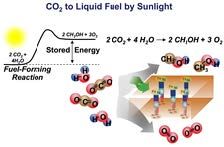Thrust 2: SOLAR-TO-FUEL CONVERSION
Focus of the thrust:
- Comprehensive synthesis platform
- State of the art rapid screening and evaluation
- Predictive electronic structure theory
- Advanced microscopy techniques
The present state of human existence relies nearly completely on energy derived from fossil fuels; coal, oil, and natural gas provide 82% of the world’s primary energy use. The effects of the carbon dioxide produced by the use of these fuels on the current and future climate of the planet have been well-documented by the Intergovernmental Panel on Climate Change (IPCC). A sustainable energy future for the world will require a radical change in energy generation. In particular, there is a critical need for sustainable fuels, for example in the transportation sector. While biofuels may be able to fill some of this demand, creation of “artificial photosynthesis” approaches with much high solar conversion efficiencies will be essential on a global basis.

The goal of Thrust 2 is the production of fuels directly from sunlight.
Solar energy can be used to produce clean fuels efficiently. It is thus important to explore pathways to convert CO2 into fuels (such as methanol, formic acid and other higher order fuels), using the energy of solar photons to catalyze the chemical reaction. Use of the abundant, renewable solar energy may provide efficient routes to producing fuel without negative impact to the environment.
This thrust focuses on discovering new catalysts, which will be powered by solar energy to convert carbon dioxide to hydrocarbons, providing a sustainable alternative to fossil fuels. The approaches are organized in two main tasks: using a comprehensive synthesis platform in combination with state of the art rapid screening and evaluation techniques to discover new solar fuels catalysts. Cross-cutting activities in predictive electronic structure theory and advanced electron microscopy are used to guide the discovery efforts.